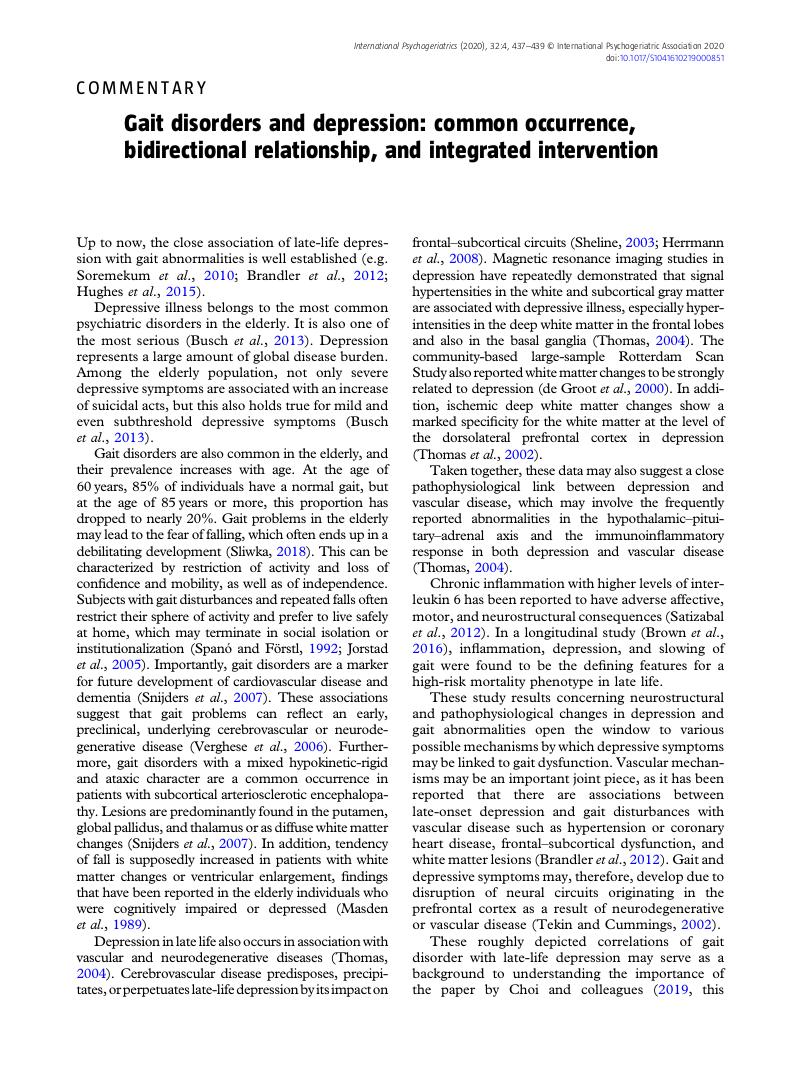No CrossRef data available.
Article contents
Gait disorders and depression: common occurrence, bidirectional relationship, and integrated intervention
Published online by Cambridge University Press: 16 April 2020
Abstract
An abstract is not available for this content so a preview has been provided. Please use the Get access link above for information on how to access this content.

- Type
- Commentary
- Information
- International Psychogeriatrics , Volume 32 , Issue 4: Issue Theme: Serious Mental Illnesses in Older Adults , April 2020 , pp. 437 - 439
- Copyright
- © International Psychogeriatric Association 2020
References
Ambrose, A., Levalley, A. and Verghese, J. (2006). A comparison of community-residing older adults with frontal and parkinsonian gaits. Journal of Neurological Science, 248, 215–218.CrossRefGoogle ScholarPubMed
Brandler, T. C., Wang, C., Oh-Park, M., Holtzer, R. and Verghese, J. (2012). Depressive symptoms and gait dysfunction in the elderly. American Journal of Geriatric Psychiatry, 20, 425–432.CrossRefGoogle ScholarPubMed
Brown, P. J.et al. (2016). Inflammation, depression, and slow gait: a high mortality phenotype in later life. The Journals of Gerontology, 71, 221–227.Google ScholarPubMed
Busch, M. A., Maske, U. E., Ryl, L., Schlack, R. and Hapke, U. (2013). Prävalenz von depressiver Symptomatik und diagnostizierter depression bei Erwachsenen in Deutschland. Bundesgesundheitsblatt, 56, 733–739.CrossRefGoogle Scholar
Choi, N., Gell, N., DiNitto, D., Marti, C. N. and Kunik, M. (2019). Depression and activity-limiting fall worry among older adults: longitudinal reciprocal relationships. International Psychogeriatrics, 32, 495–504.CrossRefGoogle ScholarPubMed
de Groot, J. C., de Leeuw, F., Oudkirk, M., Hofman, A., Jolles, J. and Breteler, M. B. (2000). Cerebral white matter lesions and depressive symptoms in elderly adults. Archives of General Psychiatry, 57, 1071–1076.CrossRefGoogle ScholarPubMed
Herrmann, L. L., Le Masurier, M., Ebmeier, K.P. (2008). White matter hyperintensities in late-life depression: a systematic review. Journal of Neurology Neurosurgery Psychiatry, 79, 619–624.CrossRefGoogle ScholarPubMed
Hughes, C. C., Kneebone, I. I., Jones, F. and Brady, B. (2015). A theoretical and empirical review of psychological factors associated with falls-related psychological concerns in community-dwelling older people. International Psychogeriatrics, 27, 1071–1087.CrossRefGoogle ScholarPubMed
Jorstad, E. C., Hauer, K., Becker, C., Lamb, and , S. E. (2005). Measuring the psychological outcomes of falling: a systematic review. Journal of the American Geriatric Society, 53, 501–510.CrossRefGoogle ScholarPubMed
Masden, J. C.et al. (1989). Brain white matter changes in the elderly prone to falling. Archives of Neurology, 46, 1292–1296.CrossRefGoogle Scholar
Satizabal, L. C. L., Zhu, Y. C., Mazoyer, B., Dufouil, C. and Tzourio, C. (2012). Circulating IL-6 and CRP are associated with MRI findings in the elderly: the 3C-Dijon Study. Neurology, 78, 720–727.CrossRefGoogle ScholarPubMed
Sheline, Y. (2003). Neuroimaging studies of mood disorders effects on the brain. Biological Psychiatry, 54, 338–352.CrossRefGoogle Scholar
Sliwka, U. (2018). Stürze im Alter – eine interdisziplinäre Herausforderung. Info Neurologie Psychiatrie, 20, 28–36.CrossRefGoogle Scholar
Snijders, A. H., van de Warrenburg, B. P., Giladi, N. and Bloem, B. R. (2007). Neurological gait disorders in elderly people: clinical approach and classification. Lancet Neurology, 6, 63–74.CrossRefGoogle ScholarPubMed
Soremekum, M., Stewart, R., Portet, F., Artero, S., Ancelin, M. L. and Ritchie, K. (2010). Neurological signs and late-life depressive symptoms in a community population: the ESPRIT study. International Journal of Geriatric Psychiatry, 25, 672–678.CrossRefGoogle Scholar
Spanó, A. and Förstl, H. (1992). Falling and the fear of it (editorial). International Journal of Geriatric Psychiatry, 7, 149–151.CrossRefGoogle Scholar
Tekin, S. and Cummings, J. L. (2002). Frontal-subcortical neuronal circuits and clinical neuropsychiatry – an update. Journal of Psychosomatic Research, 53, 647–654.CrossRefGoogle ScholarPubMed
Thomas, A. (2004). Criteria are needed for research in vascular depression. International Psychogeriatrics, 16, 3–8.CrossRefGoogle ScholarPubMed
Thomas, A. J.et al. (2002). Ischemic basis for deep white matter hypertensities in major depression: a neuropathological study. Archives of General Psychiatry, 59, 785–792.CrossRefGoogle Scholar
Verghese, J., Levalley, A., Hall, C. B., Katz, M. J., Ambrose, A. F. and Lipton, R. B. (2006). Epidemiology of gait disorders in community-residing older adults. Journal of the American Geriatric Society, 54, 255–261.CrossRefGoogle ScholarPubMed




